
What is the Candidate Experience and How to do it right?
Why Candidate Experience Matters in 2025
The role of candidate experience in a competitive market
The hiring market continues to shift quickly, and candidates now have more choice, more visibility, and higher expectations than ever. How people experience your hiring process shapes the way they view your organisation, whether they choose to engage with you again, and ultimately whether they accept an offer.
Candidate experience is not just a courtesy. It is a reflection of your culture, your values, and the level of professionalism behind your hiring decisions. When candidates feel informed, respected, and supported throughout the process, they are far more likely to stay engaged, speak positively about your brand, and move through each stage with confidence.
How small improvements reshape hiring outcomes
On the other hand, unclear communication, long delays, complicated applications, or inconsistent interviews can quickly damage trust. These issues lead directly to dropped applications, declined offers, or negative impressions that influence both candidates and potential customers.
As organisations prepare for 2025, improving the candidate experience has become one of the simplest and most effective ways to strengthen talent attraction, protect employer reputation, and build long-term hiring success. The following guide outlines the key elements that shape a strong candidate experience and offers practical steps to help you refine your approach from the moment a job is posted to the day a new hire starts.
What is the Candidate's Experience?
Key touchpoints across the candidate journey
The candidate experience covers every interaction a job seeker has with your organisation, starting from the moment they first see your job ad. It includes how easy it is to apply, how clearly you communicate, how prepared your interviewers are, and how you manage the period between offer and start date.
These touchpoints form a complete journey, which typically includes: (ADD DIAGRAM)
discovering the job
reading the job description
navigating the application
receiving acknowledgements and updates
completing interviews and assessments
getting feedback or outcomes
accepting an offer
transitioning into onboarding
Every step sends a message about what it is like to work with you, even before someone becomes an employee.
Why Candidate Experience Impacts Hiring Results:
How Experience influences offer acceptance
A candidate’s decision to accept or decline an offer is shaped by far more than salary or job title. Their experience during the process strongly influences whether they feel confident joining your organisation.
When communication is clear, interviews feel structured, and updates are timely, candidates are far more likely to accept offers because they trust the organisation behind them. Conversely, when the process feels slow or disorganised, candidates may withdraw. Research shows that many job seekers decline offers after experiencing a poor recruitment process, which affects immediate hiring outcomes as well as future opportunities with those same individuals.
Brand Reputation and Talent Attraction
The hiring process is often a candidate’s first real impression of a company, and that impression shapes how they talk about you. People share their experiences widely, especially when they are negative, and this can influence the perception of your employer brand across the market.
When candidates walk away feeling respected and informed, they become advocates, regardless of whether they were offered the role. When their experience is the opposite, they often share that too. Reports indicate that a significant portion of job seekers share negative recruitment experiences online, which can deter potential applicants and reduce the quality of future talent pools.
The real cost of a poor hiring process
Poor candidate experience carries business consequences beyond talent attraction.
It can affect the likelihood of candidates applying again in the future and even influence their relationship with your company as a customer. Insights suggest that a notable proportion of candidates with negative recruitment experiences say they would avoid purchasing from the organisation involved.
In addition, many candidates say they would not reapply to a company unless their previous experience was positive. This means businesses risk losing access to individuals who may have been strong future hires simply because their initial interaction was not handled well.
A thoughtful, efficient and respectful candidate experience does more than fill roles. It protects your brand, supports long-term talent pipelines, and strengthens your organisation’s reputation both inside and outside the recruitment process.
How to Plan Your Hiring Needs Effectively
Clarifying the role and expectations
A strong candidate experience starts before a job is even advertised. When a role is unclear or poorly defined, it leads to confusion for the hiring team and a frustrating experience for candidates. Clear planning helps you identify what the role truly requires, which responsibilities matter most, and the type of person who will succeed in the position.
Taking the time to define the purpose of the role, the outcomes it is responsible for, and the non-negotiable competencies creates clarity for everyone involved. Candidates receive a much more accurate picture of the job, which reduces misunderstandings later in the process and supports stronger engagement from the start.
Use skill-gap insights effectively
A skill-gap analysis is one of the simplest ways to understand what skills already exist within your team and where new capability is needed. This can be done at an individual or team level and helps determine whether you genuinely need to hire or whether training or internal mobility could address the gap.
When a new hire is needed, the skill-gap analysis provides a grounded, evidence-based foundation for writing the job description and assessing candidates. It helps you focus on the capabilities that truly matter, rather than building long or unrealistic requirement lists that deter strong applicants.

How internal input strengthens role definition
The people currently doing the work often have the clearest insight into what the role involves day to day. Speaking with team members, managers, or stakeholders who regularly interact with the position can reveal responsibilities, challenges, and expectations that may not be captured in a standard job brief.
This input helps refine the role, strengthens accuracy, and ensures the job description reflects the reality of the position rather than assumptions. When candidates see a clear, realistic description, they are better able to self-assess, ask informed questions, and feel confident that the process is organised and transparent.
Strong role definition reduces friction throughout the entire hiring process and supports a better experience for both candidates and hiring teams
READ MORE: Talent Mapping: The Ultimate Guide to Strategic Workforce Planning
How to Write Job Ads That Attract Strong Candidates
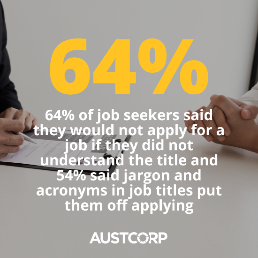
Clear job titles and must-have requirements
Job seekers search using standard job titles, not creative or unusual variations. Clear, recognised titles improve visibility on job boards and search engines and help candidates quickly understand what the role is. Titles like “Marketing Manager” perform far better than titles such as “Growth Guru” or “Brand Superstar,” which often reduce search visibility and credibility.
It is also important to avoid overwhelming candidates with long lists of requirements. When everything is listed as essential, strong applicants may self-exclude because they do not meet one or two less-critical criteria. Separating true must-haves from nice-to-haves creates a more accurate picture of the role and encourages more qualified candidates to apply.
Communicating what candidates care about
A common mistake in job ads is focusing heavily on what the organisation wants, without explaining what the candidate will gain in return. Research shows ads focused on what the employer is offering are three times more likely to attract high-quality applicants than those who don't. Remember, candidates are tuned into "What's in it for me?". Your ad should answer that question.
SO reflect on what your organisation genuinely offers. Speak to your team to understand what they value most and highlight the elements that matter most to candidates.
Work-Life Balance: Be specific. Instead of vague statements, offer specific benefits such as "We offer the flexibility to work from home twice a week".
Career Development: Mention any opportunities for growth, training programs or educational assistance.
Company Culture: Describe the environment, teamwork, and leadership style in concrete terms.
Unique Perks: Highlight benefits or programs that set you apart from competitors.
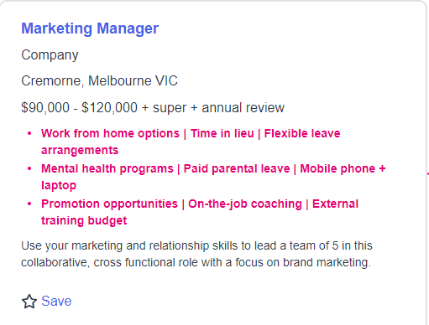
To ensure your benefits align with shared candidate preferences, use resources like Seek Law of Attraction Data to understand what drives the candidates in your market.
Using inclusive and accessible language
Language plays a significant role in how candidates perceive your organisation. Certain words, phrases, or assumptions can unintentionally exclude people based on gender, age, background, or accessibility needs. Reviewing your phrasing ensures your ads are welcoming and reflective of a diverse workforce.
Focus on:
Removing gendered words and pronouns (e.g., use "Salesperson" instead of "Salesman")
Eliminate derogatory or stereotypical terms
Use neutral language that doesn't exclude any group based on age, race, disability, or other protected characteristics.
Tools like Textiocan help identify biased language and suggest more inclusive alternatives, but a thoughtful human review remains just as important.

Structuring job ads for readability
The formatting of your job ad is just as important as the content. A well-structured ad is easier to skim, more visually appealing, and more likely to keep candidates engaged.
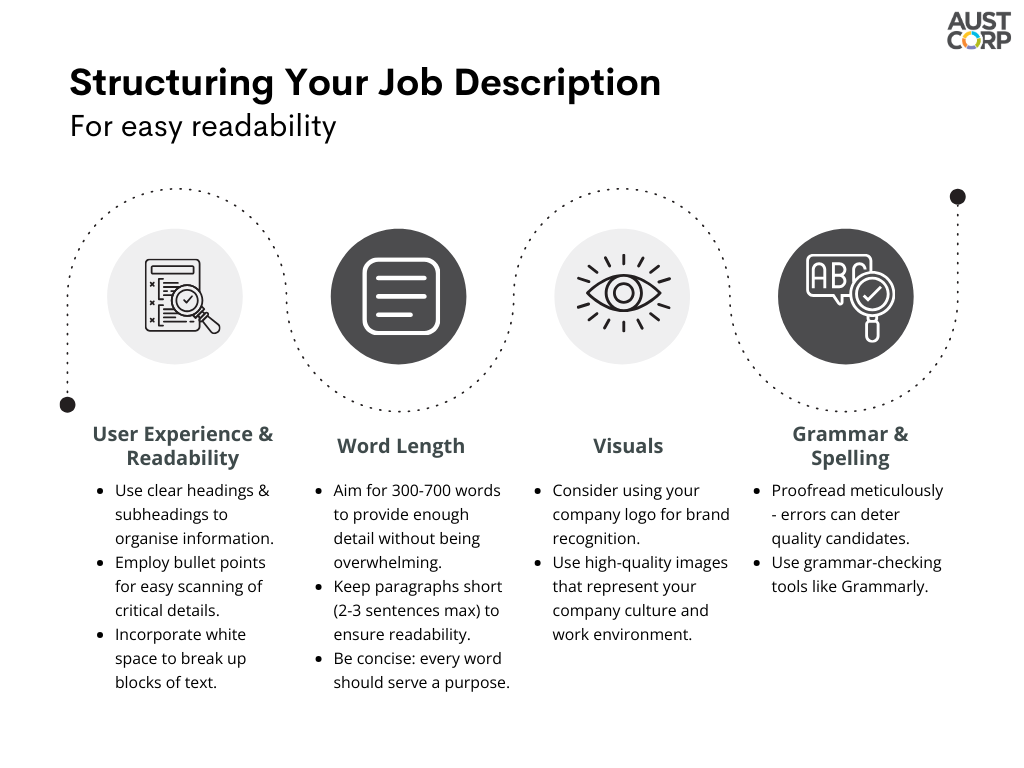
READ MORE:"How to guide on writing attractive ads that attract your target candidiate".
How to Show Candidates the Information They Need
What your careers page should include
Candidates research employers long before they apply. They want to understand your culture, values, work environment, and opportunities for growth so they can decide whether your organisation aligns with their goals. Your careers page plays a central role in this. It is often one of the first places candidates visit, and the quality of that experience influences their decision to move forward.
A strong careers page should be easy to navigate and updated regularly. It should give candidates a clear, honest picture of what your organisation offers, including:
Compensation transparency, where possible
Professional development opportunities, such as training, mentoring, and long-term progression
Work-life balance expectations, stated clearly and without vague language
Purpose, missions, and impact, so candidates understand how their work contributes to broader goals.
Showcasing culture, development, and impact
Beyond the basics, candidates want to see what it actually feels like to work at your organisation. Sharing authentic examples of team interactions, cultural moments, and career journeys helps them visualise their potential experience.
Consider using
Employee testimonials that reflect real voices and real experience
Short videos that show a typical workday or introduce teams and leaders.
Stories of progression to highlight development opportunities.
Snapshots of team culture, such as community involvement or internal initiatives
This type of content brings your workplace to life and strengthens your employer brand by showing rather than telling.
Using employee stories and social proof
Your social channels also influence the candidate experience. Regular updates about your people, advantages, and your workplace culture help candidates stay informed and engaged, even if they're not currently applying.
Posting consistently about company news, events, and milestones helps build familiarity and trust. Using dedicated career or culture hashtags can also help candidates navigate your content more easily, whilst encouraging engagement.
Employee-generated content is equally powerful. When candidates see authentic posts from people doing the work, it adds credibility and makes your organisation more approachable.
Making this information easy to access across your website, LinkedIn, and other professional networks can significantly improve the experience, whilst encouraging candidates to explore opportunities with you.
READ MORE: The ROI of Employer Branding: How to Create a Compelling Workplace Brand
How to Create a Simple and Inclusive Application Process
Reducing friction and unnecessary steps
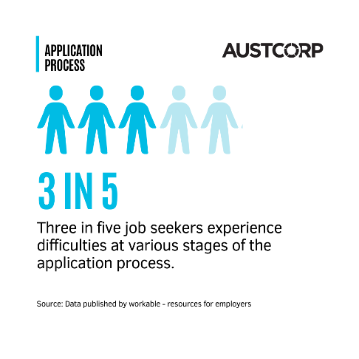
A smooth application process sets the tone for the entire candidate experience. When forms are long, repetitive, or difficult to complete, candidates quickly lose interest. Many job seekers prefer short, straightforward applications, and a significant portion expect no more than 10–15 essential questions.
Your goal at this stage is not to assess every detail of a candidate’s background. It is simple to confirm whether they meet the basic requirements for a phone discussion. Keeping the process concise prevents drop-offs and shows respect for the candidate’s time.
Once candidates find your job ad, they should be able to start the application with minimal clicks. Make sure the page is easy to navigate, loads quickly, and does not require unnecessary account creation or duplicate information entry. Removing these obstacles encourages more people to complete the process and supports a more positive perception of your organisation.
Designing a mobile-first experience
With 90% of job seekers using a mobile device when looking for a job, mobile optimisation is expected among job seekers. This means your application process must be fully mobile-friendly. Pages should load properly on smaller screens, forms should be easy to scroll through, and all fields should be clearly visible and easy to complete.
Allowing candidates to link their LinkedIn profile or portfolio also helps streamline the process. It reduces the time spent uploading documents and makes it easier for applicants to apply quickly without compromising quality.
Providing clear instructions and expectations
With 93% of job seekers reporting confusion due to job ads or application pages lacking clear instructions, providing straightforward and transparent information is essential in order to reduce confusion and increase completion rates.
Explain what candidates need to prepare, outline any additional documents required, and set expectations about what will happen after they submit their application.
Keeping the form concise and well-structured also helps candidates gather everything they need without getting lost in multiple pages or unnecessary steps.
Offering flexible application methods
Application preferences have evolved. Candidates now expect options that allow them to choose how they apply. Traditional resume-and-cover-letter submissions still work for some roles, but many job seekers prefer alternatives such as one-click LinkedIn applications, short video introductions, or portfolio links.
Offering flexible options makes the process more inclusive and supports different communication styles. It also signals that your organisation is adaptable and considerate of applicants’ time and preferences.
Providing variety does not compromise the quality of your assessment. It simply creates a more welcoming entry point for a broader range of candidates and improves the overall experience from the very first step.
How to Communicate With Candidates at Every Stage
Clear and consistent communication is one of the strongest indicators of a professional hiring process. Candidates want to understand where they stand, what comes next and how long each stage will take. When communication is delayed or irregular, people often assume the process has stalled, which leads to uncertainty and early withdrawal from the pipeline.
The format does not need to be complicated. Short, direct messages are often the most effective, especially when paired with clear timelines and simple next steps. Automated acknowledgements and templated updates can help maintain consistency while reducing manual workload for hiring teams.
The diagram below outlines the key points in the hiring process where communication makes the biggest difference. These moments set expectations, keep candidates informed and ensure no one is left guessing at any stage of the journey.
How to Run Fair and Structured Interviews
A well-run interview process does more than assess capability. It shapes how candidates view your organisation and determines whether they feel respected, informed, and confident throughout the process. Candidates are evaluating you just as closely as you are evaluating them, so it is essential that interviews feel organised, fair and considerate of their time and effort.
Preparing interviewers properly
Candidates can tell very quickly when an interviewer is unprepared. When the interviewer has not reviewed the candidate’s background, asks repetitive questions, or appears unsure about the structure of the interview, it creates a poor impression and raises doubts about the organisation’s professionalism.
Preparing interviewers properly helps avoid this.
Candidate Profile Access: Interviewers should have easy access to comprehensive information about the candidate directly within the interview link or platform.
Pre-Defined Questions: Collaborate with hiring managers to create relevant and appropriate questions tailored to the role.
Evaluation Scales: Implement rating scales (1-5 or 1-10) for each question to simplify the evaluation process.
Rating Guidelines: Establish clear criteria for each score to maintain evaluation objectivity.
When interviewers feel equipped and confident, the experience is better for everyone involved.
Using structured, competency-based questions
The distinction between structured and unstructured interviews is straightforward, yet it can significantly impact the hiring process.
In an unstructured interview, the interviewer can ask questions at their discretion, determining the content and sequence of inquiries. This approach often leads to a more conversational atmosphere but can result in inconsistencies and challenges in evaluating candidates fairly.
Conversely, a structured interview involves predetermined questions in a specific order. This method allows you to focus on key competencies relevant to the role and facilitates easier comparison of candidate responses. By having a clear framework, you streamline your evaluation process and enhance the candidate experience.
Considering that interested applicants will prepare thoroughly to address the core competencies outlined in the job description, unstructured interviews pose the risk of interviewers straying off-topic, preventing candidates from fully demonstrating their suitability for the position. In contrast, structured interviews provide candidates with a better opportunity to showcase their capabilities, making it more straightforward for you to assess their fit for the role.
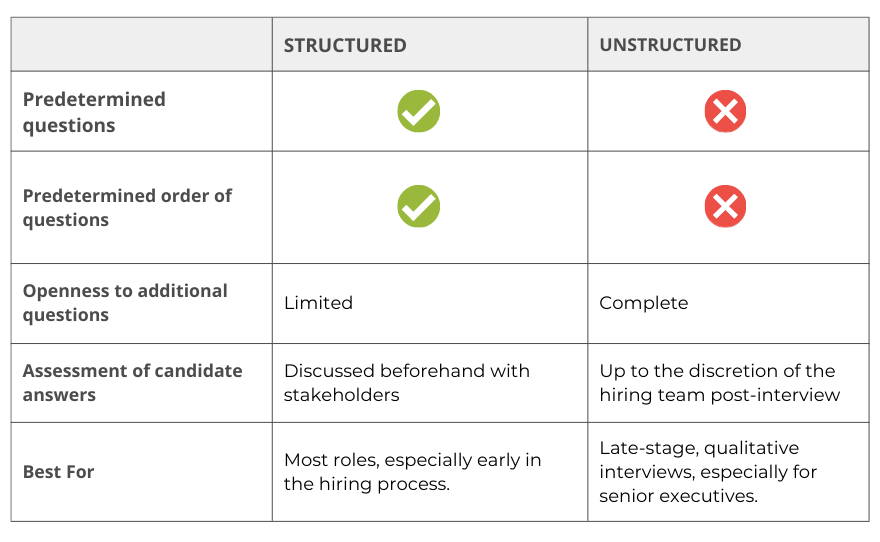
Minimising bias in the evaluation process
Interview bias can influence decisions without people realising it. Personal preferences, first impressions, or assumptions can lead to inconsistent assessments and, ultimately, poor hiring decisions.

To avoid making these mistakes (MAKE DIAGRAM?)
Use standardised questions: For each job, have a set of questions you ask each candidate in the same order. This way, you don't veer into similar-to-me bias or inconsistency in questioning.
Grade candidates on a rubric: Before you begin the interview process, determine which skills are essential and look at those skills individually. This will help you avoid stereotyping, first impression bias, contrast effect, etc.
Require anonymous test assignments: These should be short and non-actual work that benefits the business. Every candidate should receive the same assignment – whether writing a piece of code, analysing a data set, etc., and each candidate should be marked anonymously, judging the work product without identifying candidates. This will help eliminate all biases if the work is directly related to the job's needs.
Have multiple people interview the candidate: Each interviewer should have questions about their expertise and job requirements. The candidate may feel they are answering the same questions with different interviewers, but the idea is to get a clear picture while reducing bias.
Don't use your gut: Sometimes, you may like a candidate or feel that this person is best. Using the above methods to evaluate candidates will give you a quantifiable answer for the best candidate. Your gut will often use your own biases disguised as intuition.
Respecting time and creating a calm, organised environment
Candidates should arrive at an interview knowing exactly what to expect. Sharing clear details such as the time, location, format and who they will be meeting with helps them prepare and reduces unnecessary stress. Some organisations also choose to share interview questions in advance, which allows candidates to focus on the substance of their answers rather than the pressure of thinking on the spot.
This transparency helps candidates know what to expect, which can ease their nerves on the day of the interview.

Ending the interview with clarity and next steps
Wrapping up the interview professionally and transparently ensures a positive candidate experience and sets clear expectations.
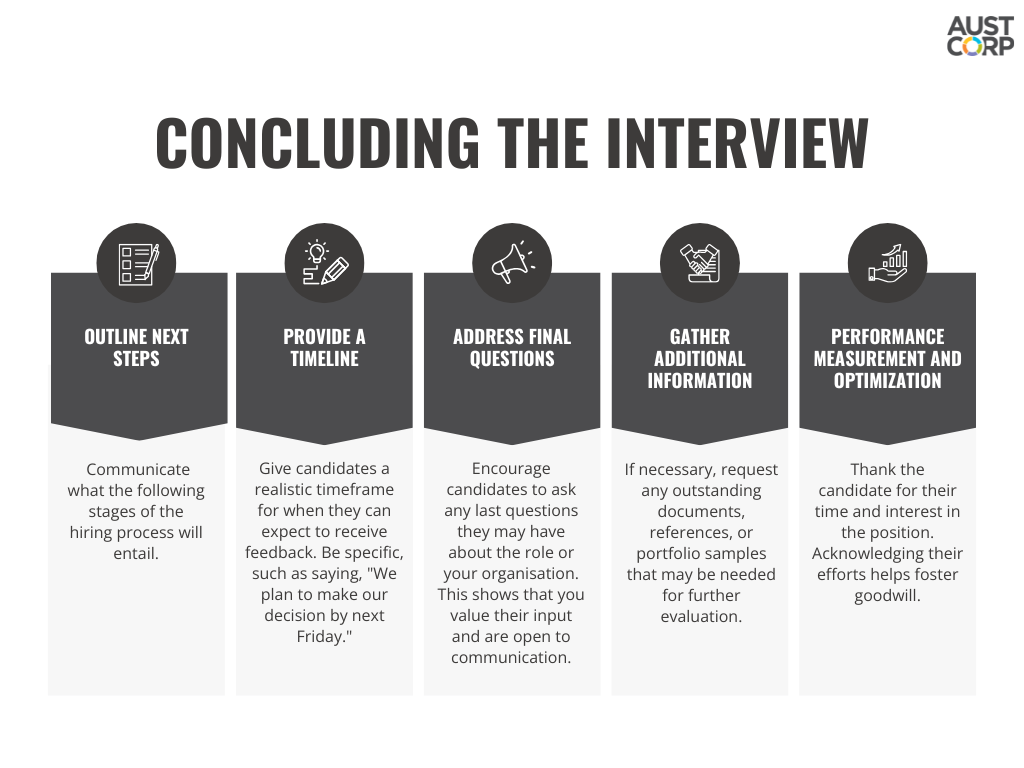
A strong conclusion reinforces your brand and leaves candidates with a positive impression, regardless of the final decision. It signals that your organisation operates transparently, treats people with respect, and values their time and effort.
READ MORE:"The Ultimate Guide To Conducting Interviews: Boost Your Hiring Success".
How to Provide Feedback to Candidates Professionally
Why feedback strengthens your brand
Candidates are eager to hear your insights about their performance, regardless of whether they were selected for the position. 94% of candidates desire feedback after an interview, yet only 43% have received such feedback.
Providing constructive feedback not only aids rejected candidates in their job search but also increases the likelihood that they will consider future opportunities with your organisation.
How to give concise and constructive feedback
Use Established Rating Criteria: Base your feedback on the criteria you used to evaluate candidates during the interview process.
Refer to the Job Description: Connect your feedback to specific requirements outlined in the job description to provide context and relevance.
Be Clear and Concise: Ensure your feedback is straightforward, avoiding unnecessary jargon or complexity.
Highlight Areas for Improvement: Focus on specific qualities or skills that candidates can work on, providing them with actionable insights for future interviews.
How to Maintain Engagement After the Offer
Communicating between acceptance and start date
A candidate’s experience does not end when they accept an offer. The period between acceptance and their first day is important, and silence during this time can create uncertainty or reduce their confidence in the decision. Clear, steady communication helps maintain momentum and reassures the candidate that they are joining an organised and supportive team.
A simple welcome message with next steps, preboarding instructions and an outline of what to expect in their first week is often enough. This is also a good time to invite questions or clarify any practical details. The aim is to keep communication warm, consistent and purposeful, without overwhelming the new hire.
What candidates need to feel supported
Integration into the team is vital for new hires to feel a sense of belonging. According to Gallup, employees who develop strong friendships are more engaged, productive, and satisfied.
Facilitate introductions with team members, assign a buddy or mentor to assist them during their initial days, and incorporate team-building activities into the onboarding process. Regular check-ins from managers can help new hires understand their roles within the broader team context and how they contribute to organisational goals
Bridging the candidate experience into onboarding
Onboarding is the point where the candidate experience becomes the employee experience. A structured, welcoming onboarding process helps new hires feel confident and prepared, and research shows that employees who have a strong onboarding experience are more engaged and more likely to stay long term.
Providing clarity, introducing them to the right people and giving them the support they need during their first weeks helps reinforce their decision to join and sets the foundation for a positive relationship with your organisation.
How to Measure and Improve Your Hiring Process
Improving the candidate experience is an ongoing process. The most effective organisations review their hiring performance regularly and use data to identify where the experience is strong and where candidates may be dropping off. Tracking a few key metrics provides a clear view of how well your process is working and where adjustments may be needed.
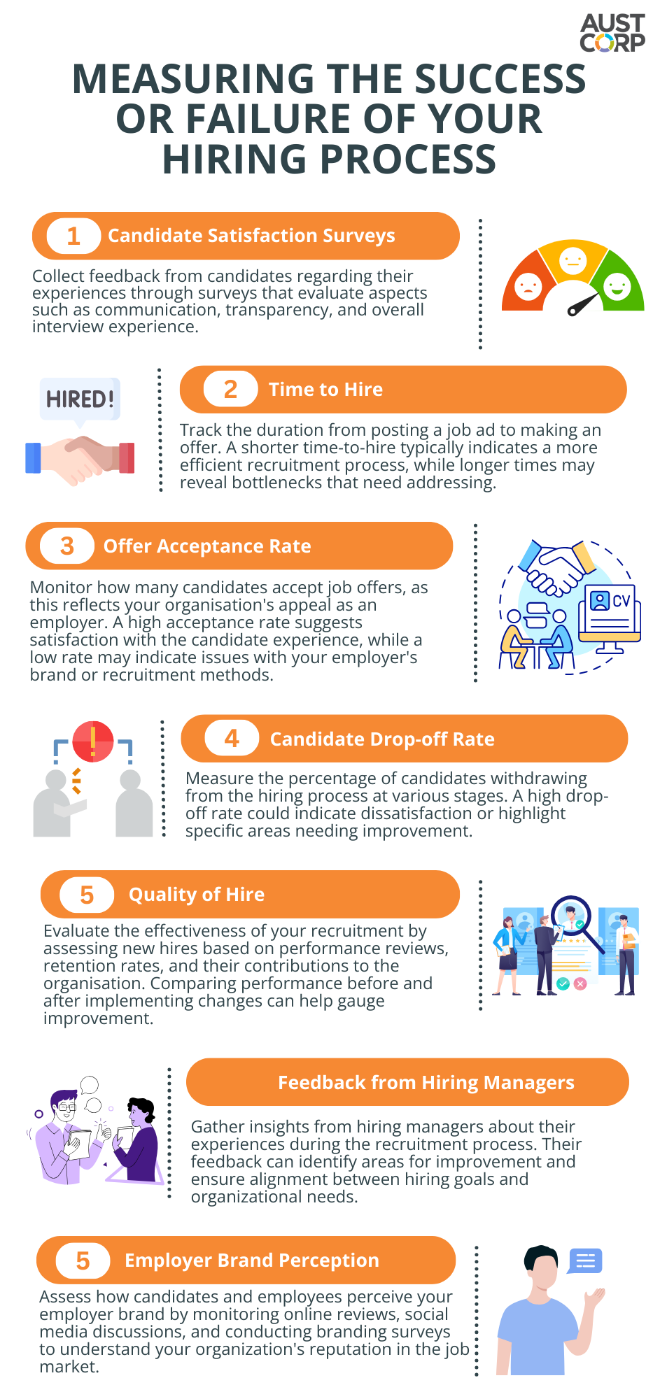
The goal is continuous improvement. Small changes informed by data can have a significant impact on how candidates experience your process and how effectively your organisation attracts and secures the right talent.
Transform Your Hiring Process: Partner with AustCorp Executive
Improving your candidate experience is an ongoing process, and the organisations that invest in it consistently see stronger engagement, better hiring outcomes, and a more positive employer brand. Many organisations know where the gaps are but struggle to find the time or structure to address them. That is where the right partnership can make all the difference.
At AustCorp Executive, we manage the full candidate experience on your behalf, ensuring every interaction is clear, consistent and aligned with the standards you want associated with your brand. From the first conversation to the final offer, we support candidates professionally, while you'll gain a stronger talent pool and better hiring outcomes without the operational strain.
Don’t let a poor hiring process hold you back from building the team you need to succeed. Reach out to us today to learn how we can help you secure the right people, the first time.
